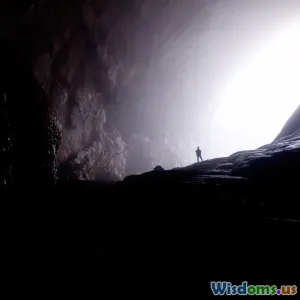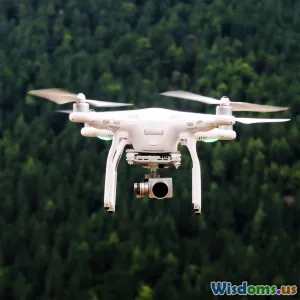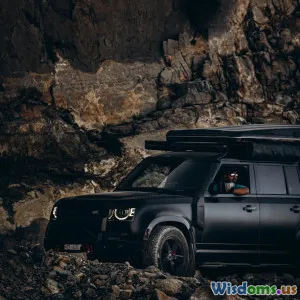
Why Humidity Makes Jungle Survival Techniques Challenging
19 min read Explore how high jungle humidity complicates survival skills, affecting hydration, shelter, and safety. (0 Reviews)
Why Humidity Makes Jungle Survival Techniques Challenging
Few environments on earth test one’s resilience and resourcefulness like the jungle. Tangled canopies, hidden wildlife, and unpredictable weather already make jungle survival complex. But towering above all challenges is a relentless, invisible force: humidity. While jungle guides and survival stories often focus on dangers like predators or poisonous plants, the humid air is a constant adversary that can foil even the most meticulous plans—making the survivalist’s journey demanding and often perilous.
When we look deeper, it becomes clear that high humidity is not simply an inconvenience. It transforms how clothing, shelter, fire-making, hydration, and body cooling strategies work—or don’t. Here’s why high humidity changes the jungle game, and what you can do to adapt.
Water Everywhere, Yet Nowhere to Drink

At first glance, surviving in a humid, water-laden jungle might seem straightforward—there’s moisture in the air, countless streams, and frequent rainstorms. But forced adaptation is essential when seemingly abundant water sources can pose grave health risks.
The Challenge of Safe Hydration
While the jungle teems with water, almost all accessible sources are rife with bacteria, parasites, and debris. Streams often serve as breeding grounds for pathogens like Giardia or Leptospira. Relentless rainfall can stir up mud and contaminants.
Example: In the Amazon, 80–90% humidity and daily downpours mean plenty of surface water—but locals and trained guides avoid drinking straight from them. Even a clear-looking stream may be tainted by animal waste upstream. Historically, even military expeditions in Southeast Asian jungles suffered from dysentery and waterborne illnesses despite plentiful water.
Dehydration in Disguise
Humidity prevents sweat from evaporating efficiently, keeping skin moist while your body still loses fluids in pursuit of cooling. A jungle trekker can lose 1–2 liters of sweat per hour just by moving, accelerating dehydration without external cues. Victims of jungle dehydration rarely feel as thirsty as they should because the damp air fools the body’s sensors.
Actionable Tips:
- Always boil, filter, or chemically treat any water found—even rainwater, which may collect debris from leaves.
- Monitor urine color as a hydration guide; very dark means you’re already behind.
- Set a timer to sip at intervals, regardless of perceived thirst.
Fire-Making Nearly Impossible

Mastering fire is pivotal in the wild: for warmth, cooking, signaling, and deterring wildlife. Yet, the perpetual dampness of a humid jungle can keep even an experienced survivalist shivering and hungry through the night.
The Issue With Wet Resources
With up to 99% humidity at ground level and frequent rains, “dry” sticks and leaves are almost mythical in the jungle. Even materials hidden under logs or inside trees absorb moisture from the air. Tinder material, often crucial for starting fire, becomes spongy, frustratingly reluctant to light.
Fact: In Southeast Asia, survival instructors report that making a fire from scratch without modern tools can take hours or fail outright if the humidity is above 85%—quite typical conditions. During World War II, soldiers often went hungry when even oily rations and carefully saved matches could not best Limbu, a local Nepali word for the relentless dampness.
Strategies for Fire Success
- Seek Natural Shelters: Look for tinder and kindling shielded by overhangs or inside hollow logs.
- Feather Sticks: Shave sticks to expose dry inner wood, increasing surface area for easier ignition.
- Synthetic Fire Starters: Waterproof matches, pocket-sized firelighters, or even cotton balls soaked in petroleum jelly provide much-needed reliability; many seasoned jungle guides never travel without them.
- Pace Yourself: In humid conditions, making and maintaining a fire requires more patience and resourcefulness—expect to spend significant energy and time gathering and prepping materials.
Shelter-Building in a Damp World

In the jungle, an improvised shelter can mean the difference between a manageable night and a potentially life-threatening predicament. High humidity amplifies the risks associated with exposure.
Never Truly Dry
Clothing, bedding, and shelter materials rarely dry, even when placed near a fire. Prolonged contact with damp surfaces results in macerated skin, lowers your core temperature, and increases the risk of fungal infections, especially during multi-day treks.
Example: Explorers in the Congo commonly wrap banana leaves around structures to channel water away, building their shelters with the steepest angles possible to shed rain. Unfortunately, in high humidity, water still accumulates—condensation from breath or skin alone can soak enclosed spaces.
Humidity and Hypothermia
Despite warm air temperatures (25–35°C/77–95°F), the wet-bulb effect (when sweat no longer cools the body and the body can’t maintain its temperature) means hypothermia can still develop unexpectedly at night, especially if people are exhausted or undernourished.
Shelter Tips:
- Elevate Sleeping Area: Hammocks or raised platforms keep bodies away from waterlogged ground and crawling insects.
- Create Maximal Overhangs: Rain covers made from plastic sheets, leaves, or bark should extend well beyond the sides to guide water away.
- Ventilate: Allow airflow to minimize condensation inside the shelter, but avoid wind exposure.
- Always Change Into Dry Layers at Night: If possible, keep a spare set of clothes sealed in plastic—you may not get another chance to dry out.
Clothing and Gear Management

Jungle experts often say, “There’s no such thing as dry gear here—just less-wet gear.” Jungle humidity seeps into everything, rotting fabrics and blistering feet if managed poorly.
The Relentlessness of Moisture
Cotton clothes become dead weight, offering little insulation once soaked. Leather shoes and belts quickly rot. Even when sunny, high humidity impedes air drying. In fact, British and American WWII jungle troops abandoned conventional fabric uniforms for quick-drying synthetics and rubber-soled jungle boots, a practice still common among modern special forces.
Fighting Foot Rot and Blisters
“Trench foot” (softened, rotting skin on feet) can occur in less than a day if socks and boots remain wet. Changing or at least airing socks and shoes twice daily is considered mandatory, a timeworn rule immortalized among the British Chindits in Burma.
Tips for Managing Gear:
- Opt for synthetics or lightweight merino wool; avoid cotton blends.
- Carry waterproof dry bags or plastic liners for storing essential gear.
- Implement a daily gear check: hang clothes when possible (even if just to air, not fully dry), and inspect for fungus or bug colonies.
- Powder and air feet several times per day, prioritizing foot health above all else.
Navigation and Orientation Difficulties

The thick, constantly morphing, humid jungle landscape can quickly turn deadly for anyone who loses their bearings. Navigation techniques are often compromised not just by plant density, but by the environmental effects of humidity.
Fogged Lenses, Compasses, and Maps
High humidity and temperature differences cause eyeglasses, binoculars, and even compasses to fog up. Delicate electronics and paper maps can deteriorate rapidly—ink bleeds, paper sticks together, devices short out from condensation.
Example: Modern jungle survivalists routinely lose GPS devices or backup batteries when excess condensation gets trapped in pockets or casings, rendering potentially lifesaving electronics useless.
Overgrown Paths Disappear Overnight
Humidity drives rapid growth—lianas, vines, bamboo, and grasses reclaim trails in mere days if left unused. Natural markers rot, dissolve, or simply vanish. In the Borneo highlands, Tagalog hunters place conspicuous but biodegradable markers, knowing that regular return is necessary, or nature will erase their breadcrumbs.
Techniques to Navigate Successfully:
- Waterproof all maps/notes, and double-bag electronics.
- Adopt traditional navigation markers, like blazed bark, stacked rocks, or cords.
- Don’t rely solely on electronics; learn sun and star bearings unique to the region.
- Mark your path frequently and in diverse ways to reduce the risk of becoming directionless.
Food Preservation and Foraging Barriers

In many survival situations, edible plants, fruits, and small game are viable food sources if you know what to look for. However, humidity works hard to sabotage your efforts to preserve and consume food safely.
Rapid Spoilage
Protein-based foods (meat, fish, eggs) attract flies and maggots in a matter of hours; plant-based finds often mold, ferment, or become motley with pests overnight. Leafy greens wilt especially quickly. Even so, historically, Amazonian tribes have devised many ways to cope, such as burying or drying meat over very smoky fires, though success rates fall sharply on rainy, windless days.
Intractable Pests
Cockroaches, ants, rodents, and even monkeys are relentless, drawn by the super-strong scents that humid air exaggerates. Bamboo tubes and tightly bound reeds are favored for temporary storage by experienced foragers to reduce scavenger incursions.
Key Preservation Tips:
- Consume fresh catches or foraged food items quickly, ideally within a few hours.
- Hang food in airtight pouches, suspended by cord, when not being prepared.
- Use smoke and fire to deter pests and slow bacterial growth—though this returns us to the vexing fire-making dilemma.
- Learn to recognize spoilage markers: slime, uncharacteristic smells, and discoloration appear more quickly in constant humidity.
Physical and Psychological Effects of Humidity

Beyond the logistical, humidity imposes subtle but accumulating stressors on the human body and mind.
Accelerated Exhaustion and Illness
Sweating ceaselessly and unable to cool off effectively, the body barrels toward heat exhaustion or even heat stroke. Chronic skin infections, rashes, and fungal growths become near constants—veteran jungle operatives often end up with chronic athlete’s foot, ringworm, or sometimes worse.
Example: Marathon racers who compete in the notorious Amazon Ultra say the air itself weighs on the spirit as well as on the flesh. They cite frequent instances of hallucinations or blackouts from a combination of dehydration, sleep loss, and overwhelming thermal stress.
Mental Toll of Perpetual Dampness
Consistently wet clothes and gear wear down willpower. The discomfort, combined with insects, isolation, and looming danger, has broken even skilled explorers. Napoleon Chagnon, an anthropologist in the Yanomami territories, notes that loss of spirit from gloom, doom, and soddenness can be more crippling than any tangible threat.
Actionable Advice for Mental Resilience:
- Build routines that focus on one manageable task at a time: check shelter, inventory gear, gather water, repeat.
- Prioritize group morale if not alone—share stories, maintain a positive outlook, and acknowledge small victories.
- Practice mindfulness and preparedness before the journey: visualize discomfort and prepare to accept rather than resist constant hassle.
Adapting Traditional Skills to Humid Jungle Environments

Traditional survival manuals rarely cover the nuances of jungle humidity. Instead, centuries of indigenous knowledge offer clues for adaptation and resilience.
Re-imagining Survival Priorities
Indigenous communities—like the Penan of Borneo or Shuar in Amazonia—routinely start campfires with resin, not just dry wood. They design dwellings for airflow, not total enclosure, and select clothing materials (like rot-resistant tree bark fiber) for both utility and comfort.
Comparative Example: Western hikers may default to rain ponchos and sealed tents, while jungle dwellers make temporary shelters of woven palm or banana leaves placed high, prioritizing wind exposure over full rain blockage. These approaches accept, not fight, humidity—trading perfect dryness for faster heat and moisture dispersal.
Skills for Modern Survivalists
- Learn Firestarters from Resin & Gum: Trees like copal or camphor produce resins that light even when partially damp.
- Weave and Knot: Pick up basic weaving/knotting skills for temporary containers or makeshift gear maintenance using jungle plants.
- Local Plant Recognition: Many wild plants are inedible or toxic; local guides’ insights—a knowledge passed through generations—about what can and cannot be safely consumed are invaluable.
- Respect Local Wisdom: Listen to stories from trackers and elders. Practices that seem counterintuitive, such as airing clothes rather than trying to dry them, or building raised platforms for everything, are born from centuries of trial and error.
Embracing the Challenge

The world’s rainforests and jungles remain some of our planet’s last wild places, their humidity a signature feature, both life-sustaining and life-threatening. For adventurers, rescue professionals, and indigenous peoples alike, understanding how humidity changes the game is a cornerstone of successful jungle survival.
Ultimately, survival in the humid jungle is about adaptation—not brute force. By learning unique strategies for hydration, fire, shelter, hygiene, and food, and by respecting the invisible but ever-present challenges humidity introduces, you enrich not just your odds of survival, but your respect for the tenacity of life in these remarkable places. Every bead of sweat, every “less-wet” sock, and every improvised trick is a testament to humanity’s ingenuity when faced with the wild’s most subtle and pervasive adversary.
Rate the Post
User Reviews
Other posts in Jungle Exploration
Popular Posts















